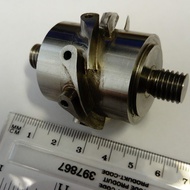Overview
This rig is composed of a 5.7m charge tube (diameter 50mm), a 0.4m test section and a 150 L reservoir tank.
The rig is operated by pressurising the charge tube and the test section by small increments. This process is controlled by a fast-acting valve that ensures that an homogeneous pressure and temperature field is achieved at the time the diaphragm bursts. The reservoir tank is evacuated in order to ensure a high pressure ratio.
This facility is designed to operate with several gases including air, CO2 and organic fluids (e.g., SF6). The utilisation of these latter (organic) fluids will require the full recovery of the gas.
Figure 1 – Schematic of Ludwieg Tube
The rig is also equipped with heater jackets in order to raise the temperature of the gas within the charge tube and prevent it from condensing when expanding (e.g., CO2). At the current stage, this rig is being used to study the in-house design of a supersonic axial vane cascade: particular attention is being given to trailing edge loss analysis. Figure 1 shows a schematic diagram of the rig, whilst a picture of the current working section is presented in Figure 2. The facility is currently being used for turbine cascade testing of ORC turbine blades.
Figure 2 – Working section.
Key facts & applications
This facility is currently being used for the study of Organic Rankine Cycle (ORC) Turbine vanes.
Key Facts
- Maximum operating pressure: 45 bar.
- Maximum operating temperature: 150 ºC.
Applications
- Turbine development for renewable power generation applications (e.g., waste heat, solar thermal, geothermal, etc.) utilising ORC technology.
